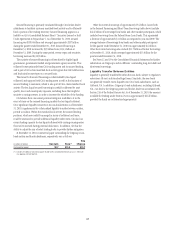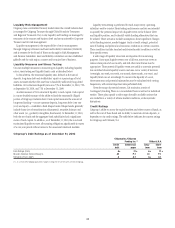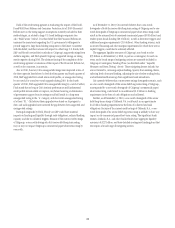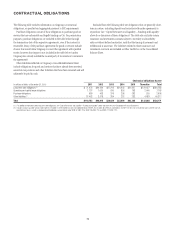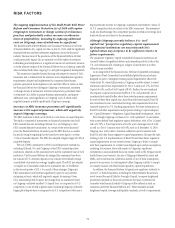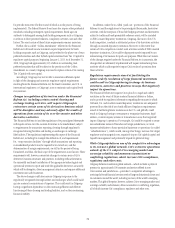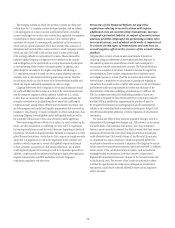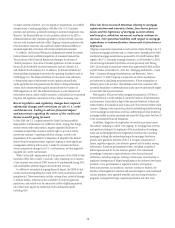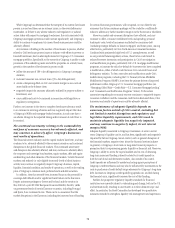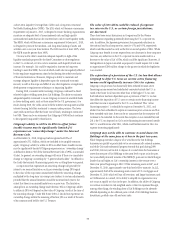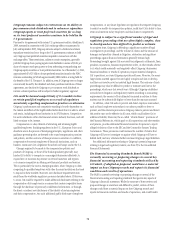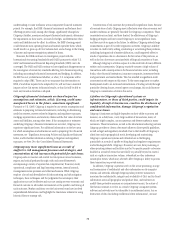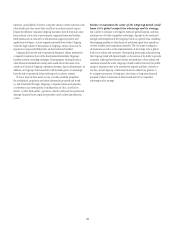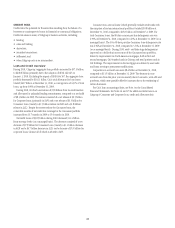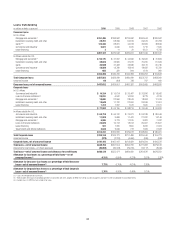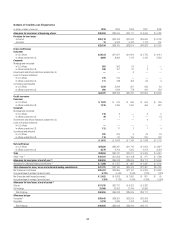Citibank 2010 Annual Report Download - page 78
Download and view the complete annual report
Please find page 78 of the 2010 Citibank annual report below. You can navigate through the pages in the report by either clicking on the pages listed below, or by using the keyword search tool below to find specific information within the annual report.76
While Citigroup has determined that the integrity of its current foreclosure
process is sound and there are no systemic issues, in the event deficiencies
materialize, or if there is any adverse industry-wide regulatory or judicial
action taken with respect to mortgage foreclosures, the costs associated with
Citigroup’s mortgage operations could increase significantly and Citigroup’s
ability to continue to implement its current foreclosure processes could be
adversely affected.
Any increase or backlog in the number of foreclosures in process, whether
related to Citi foreclosure process issues or industry-wide efforts to prevent or
forestall foreclosure, has broader implications for Citigroup’s U.S. Consumer
mortgage portfolios. Specifically, to the extent that Citigroup is unable to take
possession of the underlying assets and sell the properties on a timely basis,
growth in the number of foreclosures in process could:
inflate the amount of 180+ day delinquencies in Citigroup’s mortgage •
statistics;
increase Consumer non-accrual loans (90+ day delinquencies); •
create a dampening effect on Citi’s net interest margin as non-accrual •
assets build on the balance sheet;
negatively impact the amounts ultimately realized for property subject to •
foreclosure; and
cause additional costs to be incurred in connection with legislative or •
regulatory investigations.
Further, any increase in the time to complete foreclosure sales may result
in an increase in servicing advances and may negatively impact the value
of Citigroup’s MSRs and mortgage-backed securities, in each case due to
an adverse change in the expected timing and/or amount of cash flows to
be received.
The continued uncertainty relating to the sustainability
and pace of economic recovery has adversely affected, and
may continue to adversely affect, Citigroup’s businesses
and results of operations.
The financial services industry and the capital markets have been, and may
continue to be, adversely affected by the economic recession and continued
disruptions in the global financial markets. This continued uncertainty
and disruption has adversely affected, and may continue to adversely affect,
the corporate and sovereign bond markets, equity markets, debt and equity
underwriting and other elements of the financial markets. Volatile financial
markets and reduced (or only slightly increased) levels of client business
activity may continue to negatively impact Citigroup’s business, capital,
liquidity, financial condition and results of operations, as well as the trading
price of Citigroup’s common stock, preferred stock and debt securities.
In addition, there has recently been increased focus on the potential for
sovereign debt defaults and/or significant bank failures in the Eurozone.
Despite assistance packages to Greece and Ireland, and the creation in
May 2010 of a joint EU-IMF European Financial Stability Facility, yields
on government bonds of certain Eurozone countries, including Portugal
and Spain, have continued to rise. There can be no assurance that the
market disruptions in the Eurozone, including the increased cost of funding
for certain Eurozone governments, will not spread, nor can there be any
assurance that future assistance packages will be available or sufficiently
robust to address any further market contagion in the Eurozone or elsewhere.
Moreover, market and economic disruptions have affected, and may
continue to affect, consumer confidence levels and spending, personal
bankruptcy rates, levels of incurrence and default on consumer debt
(including strategic defaults on home mortgages) and home prices, among
other factors, particularly in Citi’s North America Consumer businesses.
Combined with persistently high levels of U.S. unemployment, as well
as any potential future regulatory actions, these factors could result in
reduced borrower interaction and participation in Citi’s loss mitigation
and modification programs, particularly Citi’s U.S. mortgage modification
programs, or increase the risk of re-default by borrowers who have completed
a modification, either of which could increase Citi’s net credit losses and
delinquency statistics. To date, asset sales and modifications under Citi’s
modification programs, including the U.S. Treasury’s Home Affordable
Modification Program (HAMP), have been the primary drivers of improved
performance within Citigroup’s U.S. Consumer mortgage portfolios (see
“Managing Global Risk—Credit Risk—U.S. Consumer Mortgage Lending”
and “Consumer Loan Modification Programs” below). To the extent
uncertainty regarding the economic recovery continues to negatively impact
consumer confidence and the consumer credit factors discussed above, Citi’s
businesses and results of operations could be adversely affected.
The maintenance of adequate liquidity depends on
numerous factors outside of Citi’s control, including but
not limited to market disruptions and regulatory and
legislative liquidity requirements, and Citi’s need to
maintain adequate liquidity has negatively impacted,
and may continue to negatively impact, its net interest
margin (NIM).
Adequate liquidity is essential to Citigroup’s businesses. As seen in recent
years, Citigroup’s liquidity can be, and has been, significantly and negatively
impacted by factors Citigroup cannot control, such as general disruption of
the financial markets, negative views about the financial services industry
in general, or Citigroup’s short-term or long-term financial prospects or
perception that it is experiencing greater liquidity or financial risk. Moreover,
Citigroup’s ability to access the capital markets and its cost of obtaining
long-term unsecured funding is directly related to its credit spreads in
both the cash bond and derivatives markets, also outside of its control.
Credit spreads are influenced by market and rating agency perceptions of
Citigroup’s creditworthiness and may also be influenced by movements in the
costs to purchasers of credit default swaps referenced to Citigroup’s long-term
debt. Increases in Citigroup’s credit qualifying spreads can, and did during
the financial crisis, significantly increase the cost of this funding.
Further, the prospective regulatory liquidity standards for financial
institutions are currently subject to rulemaking and change, both in the U.S.
and internationally, resulting in uncertainty as to their ultimate scope and
effect. In particular, the Basel Committee has developed two quantitative
measures intended to strengthen liquidity risk management and supervision:



